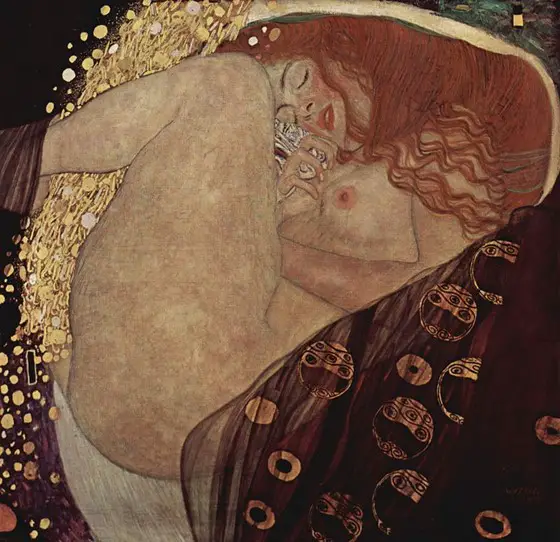
Image Source: Wikimedia commons
Paintings are one of the most common and popular forms of artistic expression throughout human history – cue stone age wall paintings. However, we have come a long way from simplistic drawings of animals carved inside the walls of caves. Along with ourselves, our art has also evolved over time. Here are 10 famous modern art paintings you should know about:
10: Hay Harvest at Éragny (1901) by Camille Pissarro

Image Source: Wikimedia commons
When one talks about impressionism and neo-impressionism, Camille Pissarro has to be part of that dialogue. Pissarro was one of the first few artists who ventured deep into the genre of impressionism. The fact that his work influenced greats like Vincent Van Gogh, Georges Seurat, Paul Gauguin, etc., speaks for his influential status in art history. Pissarro was able to exhibit his works at all Paris Impressionism exhibitions, which took place between 1874 and 1886. Born in 1830 on the island of St. Thomas, he was particularly influenced by French art masters early in his life. Thereon, his journey into the art world began as he became an assistant to the Danish painter Anton Melbye. His works have been labeled as that of great importance to art history by academicians.
His painting, Hay Harvest at Éragny, captures the simplicity in the ordinary daily tasks of country people. This painting hints at Pissarro’s eventual turn towards neo-impressionism. In fact, he is the only painter who has produced both impressionists as well as neo-impressionist works. There are also instances of pointillism in the painting. All in all, this is one of the most important and famous modern art paintings, and you should definitely know about it.
9: Ciphers and Constellations, in Love with a Woman (1941) by Joan Miró

Image Source: artic.edu
Joan Miró was born in 1893 in Barcelona, Spain. His family did not have an art background as his parents were goldsmiths and watchmakers. Joan took up drawing classes at the age of seven, and as with all children who show a tendency to become an artist, his parents did not like it. In his first exhibition, his work was not well-received by the public and critics alike. In fact, his work was defaced at that very exhibition. However, things were to change soon after. Inspired by Van Gogh, he continued with his fauvist and cubist art-style.
In 1924, Miró entered the surrealism realm. With time, his work came to be appreciated, and eventually, in 1979, Miró received a doctorate from the University of Barcelona. He died of heart failure in 1983. Yet, he lived on through his amazing artwork, which would influence a whole generation.
In his painting, ‘Ciphers and Constellations, in Love with a Woman’, Miró includes elements of Magic Realism, Surrealism, and abstraction. The painting was quite avant-garde for its time period. The painting gets a whole new meaning when looked along with the other 22 paintings, which along with this one, are a part of his series ‘Constellations’. His whole series of ‘Constellations’ is considered to be his best work by many critics.
8: Carcass of Beef (1924) by Chaïm Soutine

Image Source: Wikimedia commons
Realism has been one of the most employed artistic movements in art. Chaïm Soutine was one of the artists who excelled in creating paintings with elements of Realism in it. According to Realism, the subject matter has to be truthful and close to reality.
Soutine was born in 1893 in Russia. He started out as an impressionist but was drawn to Realism. His early works have been regarded as great contributions to the catalog of impressionist paintings.
He was heavily influenced by the European tradition, by the works of masters such as Rembrandt, Chardin, Courbet, etc. His individual style of art-form is described as a mix of abstract, impressionism, and realism. His paintings have been sold for millions, although posthumously. His love for art bordered on madness, as was seen in his creative processes.
‘Carcass of Beef’ is one of his greatest paintings and the story behind it is even greater. Due to his obsession with Realism, Soutine dragged dead cattle into his studio apartment in order to paint it. The result was the legendary ‘Carcass of Beef’, but the incident did scare the wits out of another artist who was visiting Soutine. Marc Chagall, upon seeing the blood of the dead cattle, ran out screaming, “Someone has killed Soutine”.
7: The Drowning Girl (1963) by Roy Lichtenstein

Image Source: MoMA Learning
Pop art is a recent art phenomenon that is very similar to comic book art. Andy Warhol and James Rosenquist were the pioneers of this art movement in the latter half of the 20th century. These artworks tended to use dialogue as well. Pop art included imagery from mass culture, pop culture, advertising, and comics.
It was the transformation of everyday capitalism into art. The context was deliberately removed from the artworks, which gave the audience the leeway to interpret it in various ways. Roy Lichtenstein was one of these fruiting pop artists born in 1923. He became a sensational figure in the pop art movement during the 60s, when the hippie culture and various other countercultures were raging on in the U.S.A.
In his painting, ‘The Drowning Girl’, one can see a girl apparently drowning in her own tears. The text seems to indicate that the girl is not willing to ask for help and would rather drown in her misery. The color schemes and the text seem to give this painting a very modernist look. Many art critics did not accept this movement and described it as vulgar and unoriginal. Yet, pop art continues to be an art movement with massive influence, especially when it comes to comic narratives.
6: Danaë (1907) by Gustav Klimt

Image Source: Wikimedia commons
Gustav Klimt was an Austrian artist who specialized in the symbolist art-form. His paintings emphasized spirituality, religiousness, and the exploration of the inner-self. He deliberately set his paintings against the popular Realism art movement. The philosophy that lay behind the layers of his art seemed to indicate that people had to use their imagination to bring out the beauty and meaning. This process of exploring the inner to discover more about the outer is a recurrent theme in his works.
His paintings tend to challenge the mind of a viewer. His works also contained elements of eroticism, sexual symbolism, and mythology. Klimt hit the peak of his artistic career during the 1900s. This phase of his is also called his “Golden Phase”. He was one of the few artists who actually gained a considerable amount of money from their works.
This particular painting features a naked young girl called ‘Danaë’, who, according to the mythological tales, gives birth to Perseus while being locked in a tower by her father. The father of Perseus is supposed to be the Greek God Zeus, who visited her in the tower. Klimt’s emphasis on the aspect of sexuality in his works mirrored his real lifestyle. He was the father of 14 children, and those are the ones who were officially recognized by him. He died during the Spanish Flu epidemic in 1918.
5: Full Fathom Five (1947) by Jackson Pollock

Image Source: Jackson-Pollock.org
This painting is one of the best works in the category of Abstract Expressionism. The creator of ‘Full Fathom Five’, Jackson Pollock, is considered to be one of the greatest Abstract Expressionists. His works have been the object of study for art students for a long time now. Pollock uses a technique of painting wherein the painter uses a large canvass and paints horizontally by splashing, pouring, and spraying the paint on the canvass. This technique is called action painting. It was first used by painters such as Frances Picabia and Max Ernst in the early twentieth century. However, these painters applied the paint vertically instead of horizontally. Pollock used art as therapy. He was an alcoholic trying to get better and used art as a crutch. In the end, art didn’t help him much as he died in a crash while driving under the influence.
His ‘Full Fathom Five’ is a chaotic work that expresses his inner state quite accurately. Pollock’s paintings did quite well in monetary terms, selling for millions.
4: Battle of the Lights, Coney Island (1914) by Joseph Stella

Image Source: Wikimedia commons
Joseph Stella was born in 1877 in Italy. He later moved to America to study medicine but his heart lay in the arts. He quit medical school and joined the New York School of Art. Rembrandt became one of his major influences as he studied art in school. During his school days, he created Realist works. He returned to Italy and when he came back to America, he came in contact with Modernism, which had gripped the arts of America, from painting to Literature. Futurism became his niche and then he moved on to Cubism. All in all, he was throughout his career engaged in modernist artwork.
His work ‘Battler of the Lights, Coney Island’ perfectly depicts his futuristic style of painting. Soon after the exhibition of this work, Stella became a big figure among other proponents of futurism. In New York, he was a recognizable artist. However, his work, along with the works of other modernists, was not received well by conservative critics of the time. Yet, time would prove those critics wrong as ‘Battle of the Lights, Coney Island’ would go on to become one of the most important paintings in futurism.
3: The Love Embrace of the Universe (1949) by Frida Kahlo

Image Source: Frida-Kahlo.org
Frida Kahlo was a Mexican surrealist painter born in 1907.
In her early years, she was fascinated by nature and historical artifacts. She would often do portraits of herself or other people. She would also draw paintings of nature and culturally significant artifacts. Kahlo also included aspects of native folk art in her own works. She was a very important figure in the ‘Mexicayonti’ movement, which sought out to revive indigenous religion, traditions, and philosophies of ancient Mexico. Kahlo is best known for elements of Magic Realism in her artwork. During her time, Kahlo’s art went unnoticed. It was only twenty years after her death when important American groups discovered her paintings. She became a symbol of resistance to the patriarchal powers.
Her painting ‘The Love Embrace of the Universe’ depicts Kahlo with her husband, Diego. They are both being embraced by nature and the universe. Elements of Magical Realism are quite apparent in this artwork of hers.
2: Guernica (1937) by Pablo Picasso

Image Source: Wikimedia commons
Everyone knows who Pablo Picasso is. He is considered to be the greatest painter of the 20th century. His name is on the tips of the tongues of every art major and minor. He was born in Spain and is famous because of being a pioneer of the Cubism art movement. Picasso grew up poor, but his talent in painting and drawing made adults marvel at his abilities. Picasso also dabbled in other art movements such as Surrealism, his famous ‘Blue Period’ (which isn’t exactly an art movement but was a quite significant phase in his art career), post-impressionism, etc. He even had a ‘Rose Period’, during which he made extensive use of the color red.
His painting ‘Guernica’ is considered to be his best work. This painting was his response to the bombing of the town, Guernica. The bombing took place during the Spanish Civil War. The unsettling imagery in the painting can be interpreted as the perception of horrors induced by war. Picasso was not a fan of violent regimes. When he was in Paris during World War 2, he was often harassed by Gestapo officers. The legend goes that when one of the officers found a copy of the painting ‘Guernica’ in his apartment, the officer asked, “Did you paint this?”. Pablo replied, “No, you did”.
1: The Starry Night (1889) by Vincent Van Gogh

Image Source: Wikimedia commons
Vincent Van Gogh was one of the most important and famous artists of modern times. He was known for his mesmerizingly beautiful paintings and his equally disturbed state of mind. He was a genius tormented by his own mind. His work mostly consisted of post-impressionism. Born in the Netherlands, the Dutch prodigy became involved in the art business early on when he became an art dealer. However, he was never financially successful. Van Gogh made around 2100 paintings in a decade. His works have served as a foundation on which modern art has been built. His mental health began to decline and he ended up in multiple psychiatric hospitals. His life was characterized by clinical depression and poverty. He never saw fame for his amazing art.
His “The Starry Night” is one of the most famous paintings in the whole wide world. He painted it in an asylum. The beauty of this painting is otherworldly. People wondered how Van Gogh could create something so beautiful when he was suffering inside of his own mind. Soon after his discharge from the hospital, Vincent Van Gogh shot himself. He died at the young age of 37.








